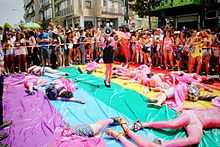LGBT marketing
LGBT marketing is the act of marketing to LGBT (Lesbian, Gay, Bisexual, Transgender) customers, either with dedicated ads or general ads, or through sponsorships of LGBT organizations and events, or through the targeted use of any other element of the marketing mix.
The LGBT market comprises a group of customers who buy goods and services from a broad range of companies across industry segments and in many countries.
History
One of the first instances of the impact of the LGBT community in the marketing world was in 1973 when Coors Brewing Company was the subject of a boycott by the LGBT. The LGBT community joined to protest Coors' hiring practices, since Coors used a polygraph test when going through the hiring process and specifically asking an employee of their sexual orientation. Coors ignored the boycott for several years, but made some concessions in 1978, and in 1995 began several countermeasures, including dropping the questions regarding homosexuality and extending domestic partnership benefits to its LGBT employees. The company also hired Mary Cheney as a marketing representative and began advertising in The Advocate and at events such as Denver's PrideFest. [1]
Statistics
Marketing to the gay and lesbian community faces statistical obstacles in that few credible peer-reviewed estimates of the gay and lesbian marketplace have been published. In particular, the common use of nonrandom “convenience surveys” of attendees at gay resorts or subscribers to gay or lesbian newspapers has resulted in some unreliable statistical estimates of gay buying power. The exact number of gays and lesbians in a given market is generally, if not always, unknown.
However, some national governments have started to publish data that include demographics of sexual orientation from census results. In the 2000 United States Census, two questions were asked that allowed same-sex partnerships to be counted, and the Census Bureau reported that there were more than 658,000 same-sex couples heading households in the United States. In 2013, the American Marketing Association reported that 3.5% of adults in the United States identify as lesbian, gay male, or bisexual and .3% of adults are transgender, and the LGBT consumer market is estimated to have an overall buying power of more than $835 billion.[2]
Advertising categories
| Marketing |
|---|
| Key concepts |
| Promotional contents |
| Promotional media |
Major ad categories include travel, financial services, alcoholic beverages, automotive, entertainment, hair and skincare, luxury goods, pharmaceuticals, and fashion. For example, American Airlines have launched a specific LGBT-targeted vacations website.[3] While over fifteen years old in the United States, LGBT marketing is a relatively new marketing phenomenon elsewhere in Australia and Europe, including Belgium[4] and the Netherlands.[5]
Many brands that have previously ignored the existence of this segment of society now increasingly target LGBT customers.[6] Time magazine in August 2006 carried a Business article on growing interest amongst brand name advertisers in Europe to target LGBT customers.[7]
In 2013, the Human Rights Campaign issued the Corporate Equality Index 2013, which provides a national benchmarking tool on corporate policies and practices related to LGBT employees in the United States. This is also used to determine a company's level of gay-friendliness.[2]
Controversies
LGBT marketing initiatives have not been without controversy both for and against them. Coors Brewing Company was the subject of a boycott by the LGBT community starting in 1973. The boycott was initiated by labor unions to protest the company's antagonistic practices, and was later joined by African Americans, Latinos, and the LGBT community.[8] The LGBT community joined to protest Coors' hiring practices - polygraph tests were often required, during which the prospective employee was asked about their sexual orientation.
Coors ignored the boycott for several years, but made some concessions in 1978, and in 1995 began several countermeasures, including dropping the questions regarding homosexuality and extending domestic partnership benefits to its LGBT employees. The company also hired Mary Cheney as a marketing representative and began advertising in The Advocate and at events such as Denver's PrideFest.
Specialist LGBT marketing agencies in various countries provide specialised LGBT market services to companies seeking to target LGBT customers.
Pinkwashing

"Pinkwashing" is a portmanteau compound word of the words "pink" and "whitewashing" that is used to describe a variety of marketing and political strategies aimed at promoting a product or an entity through an appeal to queer-friendliness, primarily by political or social activists. The phrase was originally coined by Breast Cancer Action to identify companies that claimed to support women with breast cancer while actually profiting from their illness.[9]
See also
| Look up pinkwashing in Wiktionary, the free dictionary. |
- Commercial Closet Association
- Out Now Consulting
- Pink Dollar
- Project SCUM
- Witeck-Combs Communications, Inc.
References
- ↑ Mirken, Bruce. "Coors Courts Queers".
- ↑ 2.0 2.1 Oakenfull, Gillian W., (2013) "What Matters: Factors Influencing Gay Consumers' Evaluations of 'Gay-Friendly' Corporate Activities" Journal of Public Policy & Marketing Vol. 32 (Special Issue), 79–89, American Marketing Association ISSN: 0743-9156 (print), 1547-7207 (electronic) 79. Retrieved July 16, 2013 http://www.gayadnetwork.com/files/AMAreport.pdf
- ↑ "American Airlines Vacations Welcomes You: Fly with a friend while you vacation with a partner!". Retrieved June 27, 2007.
- ↑ "Brand Activation" (in Dutch). Archived from the original on October 8, 2007. Retrieved June 27, 2007.
- ↑ "Gay Marketing Seminar" (in Dutch). Archived from the original on July 12, 2007. Retrieved June 27, 2007.
- ↑ Manning-Schaffel, Vivian (September 13, 2004). "Take Pride in your Brand". BrandChannel.com. Retrieved June 27, 2007.
- ↑ Smith, Adam (July 30, 2006). "A New Ad Adage: Same Sex Sells". Time. Retrieved June 27, 2007.
- ↑ Rapp, Linda (2004). "Boycotts". glbtq.com. Retrieved June 27, 2007.
- ↑ Schulman, Sarah. "A documentary guide to 'Brand Israel' and the art of pinkwashing". Mondoweiss. Retrieved March 22, 2014.
External links
- CommercialCloset.org - Nonprofit with worldwide LGBT marketing information.
- Gay Market News - covers latest news on gay marketing
- Survey Reveals Gay Spending Power
- Corporate America Taking Notice of GLBT Market
- Survey: Advertising Motivates Gay Consumers